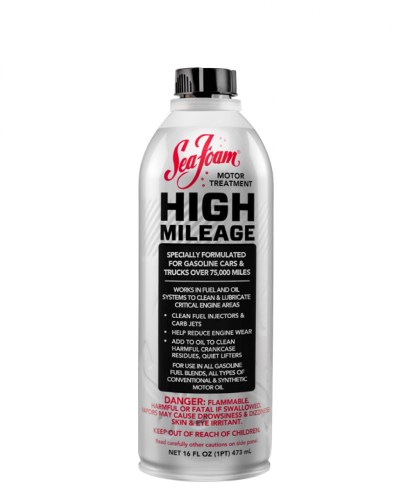Just like several individuals who utilize seafoam as an amazing engine cleanser for varnish and carbon deposits, you do as well, correct?
Yes, we cannot decline what sea foam do.
However, using sea foam can BADLY AFFECT your engine, such as making your oil thinner, leading to O2 sensor failure, creating more sludge, reducing the gas mileage, or even being incompatible with some injector systems.
In today’s post, I will explain five negative effects of seafoam, what it can do and what happens if you use too much.
Let’s dive right in!
SeaFoam: What Is It?

SeaFoam motor treatment is a product that cleans various parts of the engine. It is available in an aerosol can and small bottles for easy application. Once you apply it, the contents of SeaFoam work through the carburetor and fuel injectors to remove deposits from passageways, pistons, intake valves, and chamber areas.
According to the SeaFoam manufacturer, this motor treatment lubricates upper cylinders and can stabilize fuel for two years. In addition, SeaFoam works for both synthetic and conventional motor oils.
5 SeaFoam Negative Effects May Damage Your Engine
1. Make your oil THINNER
Why this happens?
Your engine oil has a specific viscosity for proper lubrication of the engine parts. SeaFoam has been linked to breaking down the engine oil and causing it thin out. As a result, the oil will not lubricate the engine effectively, creating excess heat and friction.
Thin motor oil causes the engine to produce a ticking sound resulting from metal parts hitting each other. You may smell burning coming from the engine, and these parts can wear out prematurely with time.
Fortunately, you can change the oil to restore proper lubrication to the engine’s parts.
Read more: What Happens If You Don’t Change Your Oil?
2. Lead to O2 Sensor FAILURE
If your O2 sensor is failing, SeaFoam can accelerate its damage such that it fails imminently. A bad O2 sensor causes rough idling, and you may hear lots of engine noises as you drive. In addition, the O2 sensor will not detect overheating, clogging, and other issues.
A bad O2 sensor reduces your MPG, and your emission levels will suffer, triggering the Check Engine Light (CEL).
3. Create MORE sludge
While SeaFoam is supposed to remove clogged sludge, it coats everything it touches since it’s a thick liquid. The result is more sludge buildup, especially in the engine’s valves, gaskets, and pistons.
SeaFoam also finds its way into the engine’s crevices and can clog up essential engine parts. The buildup gets more significant over time if you don’t clean it as soon as you discover it. Remember that sludge buildup usually leads to an overheating engine, and eventually, the motor may break down.
4. REDUCE the Gas Mileage
It’s true! Applying SeaFoam to your fuel tank will make your gas mileage suffer. Even if you use a small amount, there’s a high potential to clog the fuel system and reduce your engine’s fuel economy.
5. NOT COMPATIBLE With Some Injector Systems
SeaFoam is not suitable for engines with direct injectors. After you pour the cleaner into the engine, the product will work to loosen up dirt, debris, and sludge. However, the loosened buildup ends up clogging the injectors. There’s a high possibility for seeking repairs, especially if you have a diesel-powered direct-injection system.
Beside Negative Effects, What Can Seafoam Do?
- Remove oil varnish.
- Clean carbon deposits from intake valves and inside engine.
- Control the moisture level.
- Clean and stabilize the fuel injectors and carburetor.
Read more: Engine Hot AC Off: What Does It Mean And How To Fix It?
Read more: How To Vacuum Car AC System Without Pump
What Happens When You Use Too Much SeaFoam?
SeaFoam is 95% petroleum distillate, and the product has recommendations to use only 7.5 ounces in the crankcase. SeaFoam reduces the lubricating quality of motor oil drastically, which can cause harsh mechanical damage. Too much SeaFoam can damage rounding piston rings, cause bearings destruction, and score the cylinder walls.
Also, using too much SeaFoam in a bit to accelerate sludge removal can lead to large chunks of sludge breaking off inside the crankcase and blocking narrow oil passages. This will eventually damage engine parts. In addition, breakaways can end up in the oil filter and restrict flow, reducing engine lubrication.
The key to properly using SeaFoam for sludge removal is to add it slowly. I usually advise applying SeaFoam for only 15 minutes when the engine is idle and repeating the cleaning process over several oil changes over a couple of months.
Read more: No Brake Fluid Coming Out When Bleeding: The Causes and How to Fix
Conclusion
SeaFoam can help keep your engine clean when used correctly. Nevertheless, it’s critical to keep in mind SeaFoam’s negative effects as they are severe and can end up damaging your engine. Go ahead and use it as recommended and in the recommended amount to not hurt your engine.
Read more: Coolant Boiling in Reservoir: The Causes and How to Fix It
